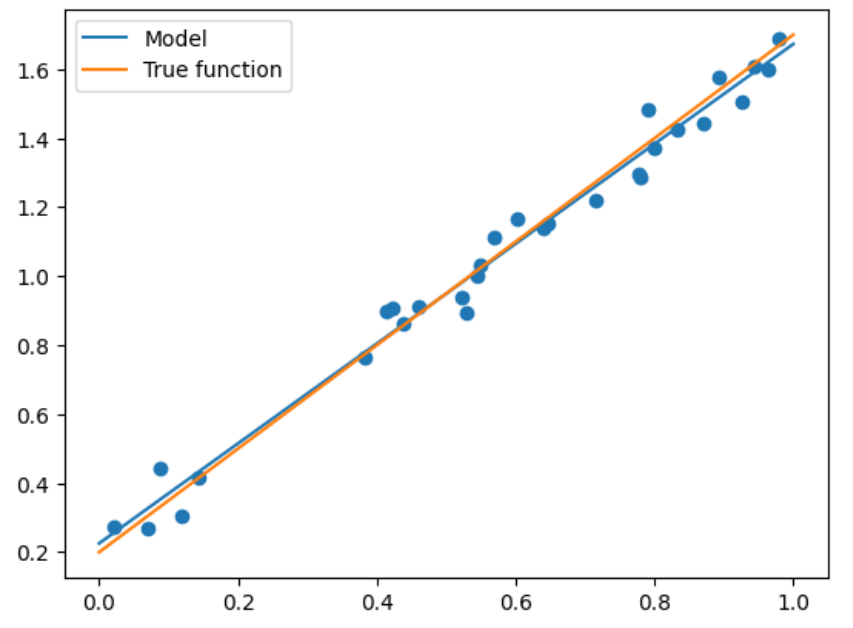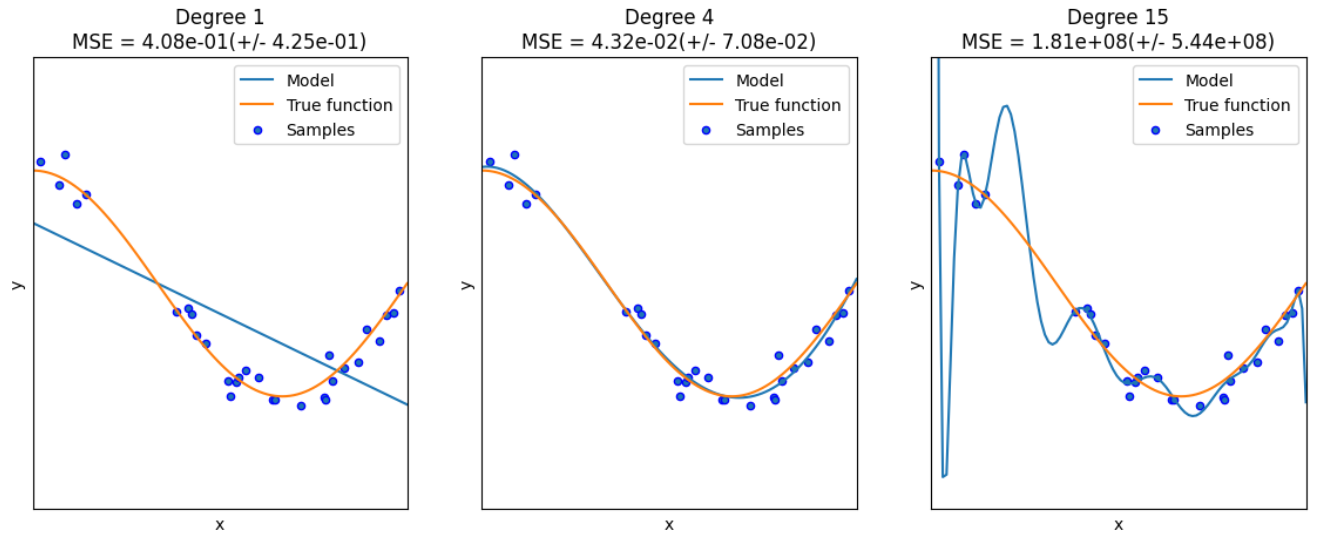基于Sklearn机器学习代码实战
作者:互联网
线性回归入门
数据生成
为了直观地看到算法的思路,我们先生成一些二维数据来直观展现
import numpy as np |
|
import matplotlib.pyplot as plt |
|
def true_fun(X): # 这是我们设定的真实函数,即ground truth的模型 |
|
return 1.5*X + 0.2 |
|
np.random.seed(0) # 设置随机种子 |
|
n_samples = 30 # 设置采样数据点的个数 |
|
'''生成随机数据作为训练集,并且加一些噪声''' |
|
X_train = np.sort(np.random.rand(n_samples)) |
|
y_train = (true_fun(X_train) + np.random.randn(n_samples) * 0.05).reshape(n_samples,1) |
|
# 训练数据是加上一定的随机噪声的 |
定义模型
我们可以直接点用sklearn中的LinearRegression即可:
from sklearn.linear_model import LinearRegression |
|
model = LinearRegression() # 这就是我们的模型 |
|
model.fit(X_train[:, np.newaxis], y_train) # 训练模型 |
|
print("输出参数w:",model.coef_) |
|
print("输出参数b:",model.intercept_) |
输出参数w: [[1.4474774]] |
|
输出参数b: [0.22557542] |
注意上面代码中的np.newaxis,因为X_train是一个一维的向量,那么其作用就是将X_train变成一个N*1的二维矩阵而已。其实写成X_train[:,None]是相同的效果。
至于为什么要这么做,你可以不这么做试一下,会报错为:
Reshape your data either using array.reshape(-1, 1) if your data has a single feature or array.reshape(1, -1) if it contains a single sample. |
可以简单理解为这是sklearn的库对训练数据的要求,不能够是一个一维的向量。
模型测试与比较
可以看到我们输出为1.44和0.22,还是很接近真实答案的,那么我们选取一批测试集来看看精度:
X_test = np.linspace(0,1,100) # 0和1之间,产生100个等间距的 |
|
plt.plot(X_test, model.predict(X_test[:, np.newaxis]), label = "Model") # 将拟合出来的散点画出 |
|
plt.plot(X_test, true_fun(X_test), label = "True function") # 真实结果 |
|
plt.scatter(X_train, y_train) # 画出训练集的点 |
|
plt.legend(loc="best") # 将标签放在最合适的位置 |
|
plt.show() |

上述情况是最简单的,但当出现更高维度时,我们就需要进行多项式回归才能够满足需求了。
多项式回归
具体实现
对于多项式回归,一般是利用线性回归求解y=∑i=1mbi×xi,因此算法如下:
import numpy as np |
|
import matplotlib.pyplot as plt |
|
from sklearn.pipeline import Pipeline |
|
from sklearn.preprocessing import PolynomialFeatures # 导入能够计算多项式特征的类 |
|
from sklearn.linear_model import LinearRegression |
|
from sklearn.model_selection import cross_val_score # 交叉验证 |
|
def true_fun(X): # 真实函数 |
|
return np.cos(1.5 * np.pi * X) |
|
np.random.seed(0) |
|
n_samples = 30 |
|
X = np.sort(np.random.rand(n_samples)) # 随机采样后排序 |
|
y = true_fun(X) + np.random.randn(n_samples) * 0.1 |
|
degrees = [1, 4, 15] # 多项式最高次,我们分别用1次,4次和15次的多项式来尝试拟合 |
|
plt.figure(figsize=(14, 5)) |
|
for i in range(len(degrees)): |
|
ax = plt.subplot(1, len(degrees), i+1) # 总共三个图,获取第i+1个图的图像柄 |
|
plt.setp(ax, xticks = (), yticks = ()) # 这是 设置ax图中的属性 |
|
polynomial_features = PolynomialFeatures(degree=degrees[i],include_bias=False) |
|
# 建立多项式回归的类,第一个参数就是多项式的最高次数,第二个是是否包含偏置 |
|
linear_regression = LinearRegression() # 线性回归 |
|
pipeline = Pipeline([("polynomial_features", polynomial_features), |
|
("linear_regression", linear_regression)]) # 使用pipline串联模型 |
|
pipeline.fit(X[:, np.newaxis], y) |
|
scores = cross_val_score(pipeline, X[:, np.newaxis], y, scoring="neg_mean_squared_error", cv=10) |
|
# 使用交叉验证,第一个参数为模型,第二个为输入,第三个为标签,第四个为误差计算方式,第五个为多少折 |
|
X_test = np.linspace(0, 1, 100) |
|
plt.plot(X_test, pipeline.predict(X_test[:, np.newaxis]), label="Model") |
|
plt.plot(X_test, true_fun(X_test), label="True function") |
|
plt.scatter(X, y, edgecolor='b', s=20, label="Samples") |
|
plt.xlabel("x") |
|
plt.ylabel("y") |
|
plt.xlim((0, 1)) |
|
plt.ylim((-2, 2)) |
|
plt.legend(loc="best") |
|
plt.title("Degree {}\nMSE = {:.2e}(+/- {:.2e})".format(degrees[i], -scores.mean(), scores.std())) |
|
plt.show() |

这里解释两个地方:
- PolynomialFeatures:这个类实际上是一个构造特征的类,因为我们原始的X是一个一维的向量,它多项式的次数为1,那我们希望构成一个多项式就需要拿X去计算X1,X2,...,Xm(这是一个变量的情况,如果是多个变量就会计算交叉乘),那么这个类就是实现这样的操作,构造成m个特征
- pipeline:这是方便我们的管道,它将各种模块加在一起让我们不用一步步去计算每一个模块,这里就是将PolynomialFeatures和线性回归模块加在一起,那我们将X传进去之后,就经过特征构造后就进行线性回归,因此拟合管道即可。
在其中我们还用到了交叉验证的思路,这部分很常见就不多做解释了。
LogisticRegression
算法思想简述
对于逻辑回归大部分是面对二分类问题,给定数据,X={x1,x2,...,},Y={y1,y2,...,}
考虑二分类任务,那么其假设函数就是:
hθ(x)=g(θTx)=g(wTx+b)=11+ewTx+b
来表示为类别1或者类别0的概率。
那么其损失函数一般是采用极大似然估计法来定义:
L(θ)=∏i=1p(yi=1∣xi)=hθ(x1)(1−hθ(x))...
这里假设y1=1,y2=0。那么就是该函数最大化,化简可得:
θ∗=argminθ(−L(θ))=argminθ−ln(L(θ))=∑i=1(−yiθTxi+ln(1+eθTxi))
再利用梯度下降即可。